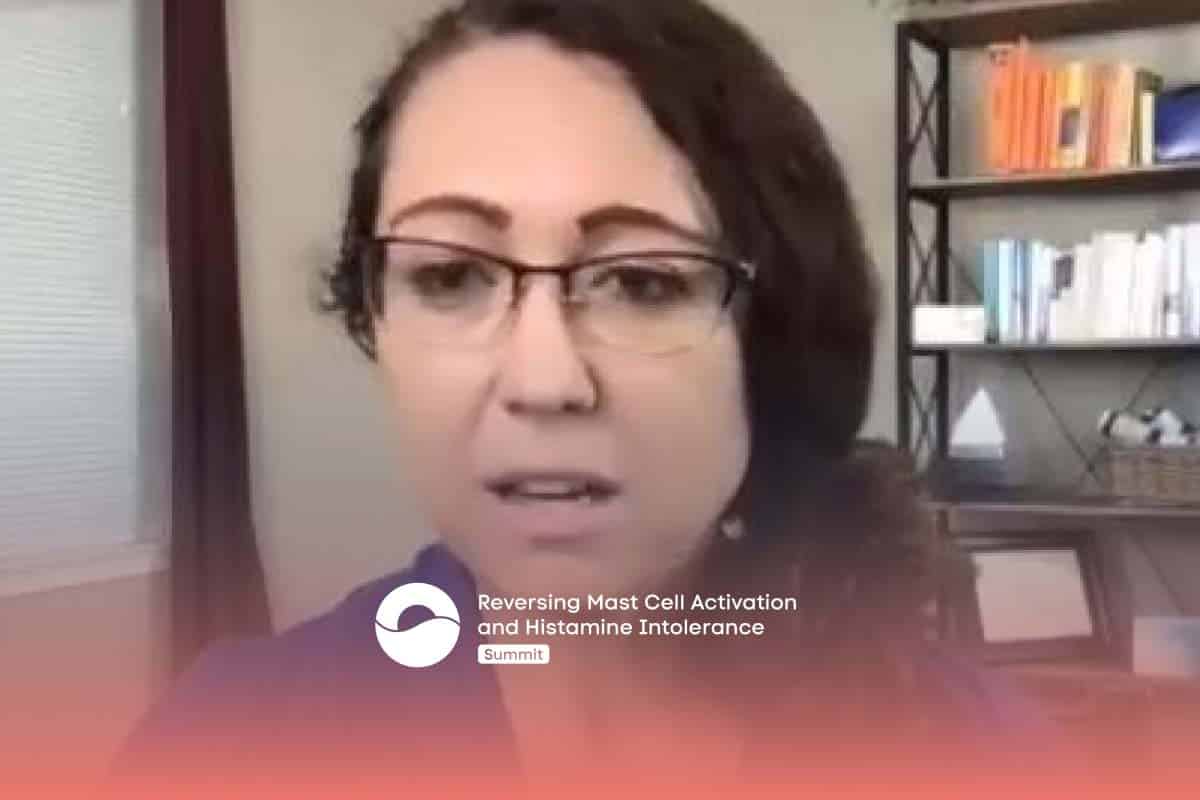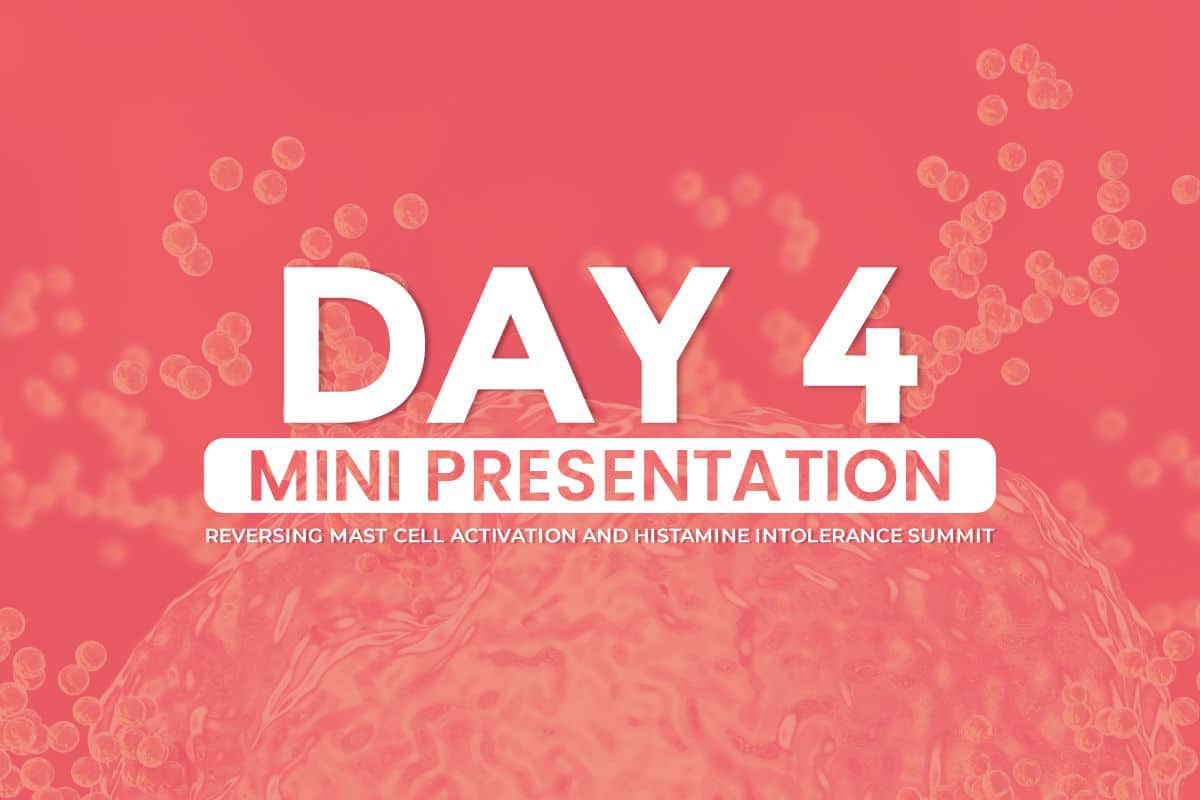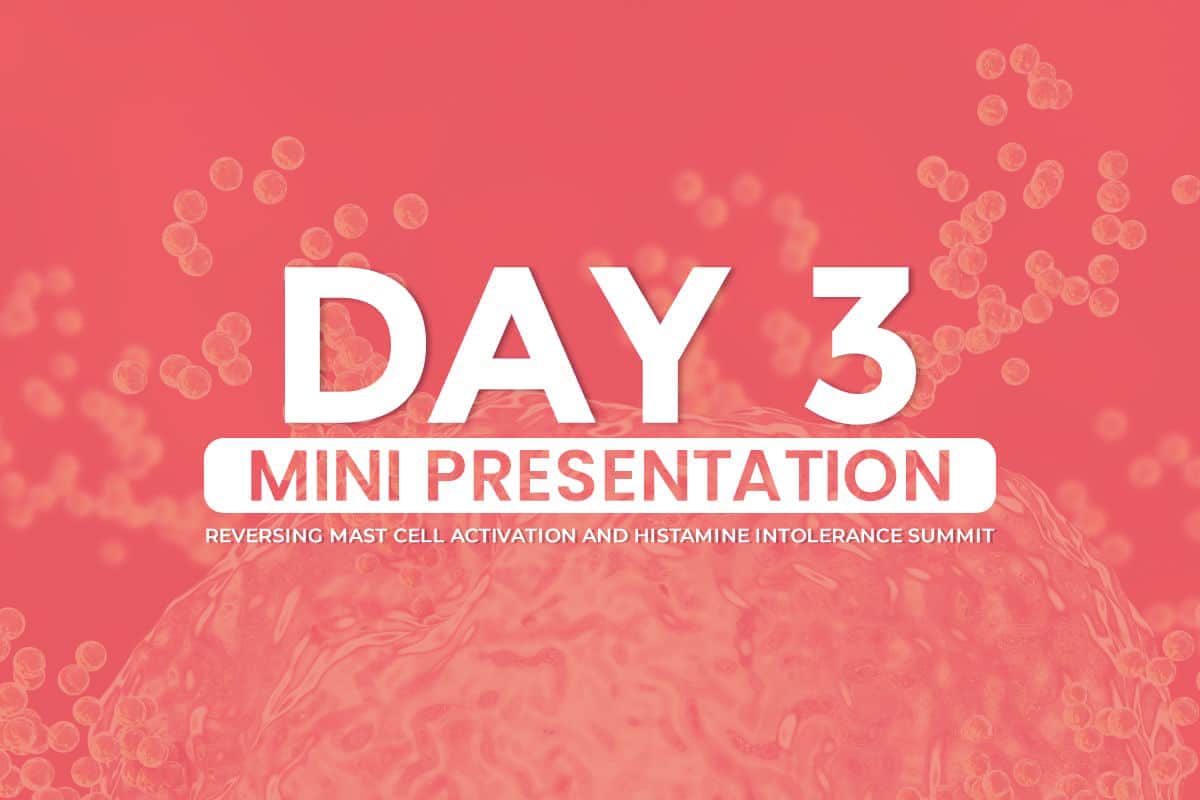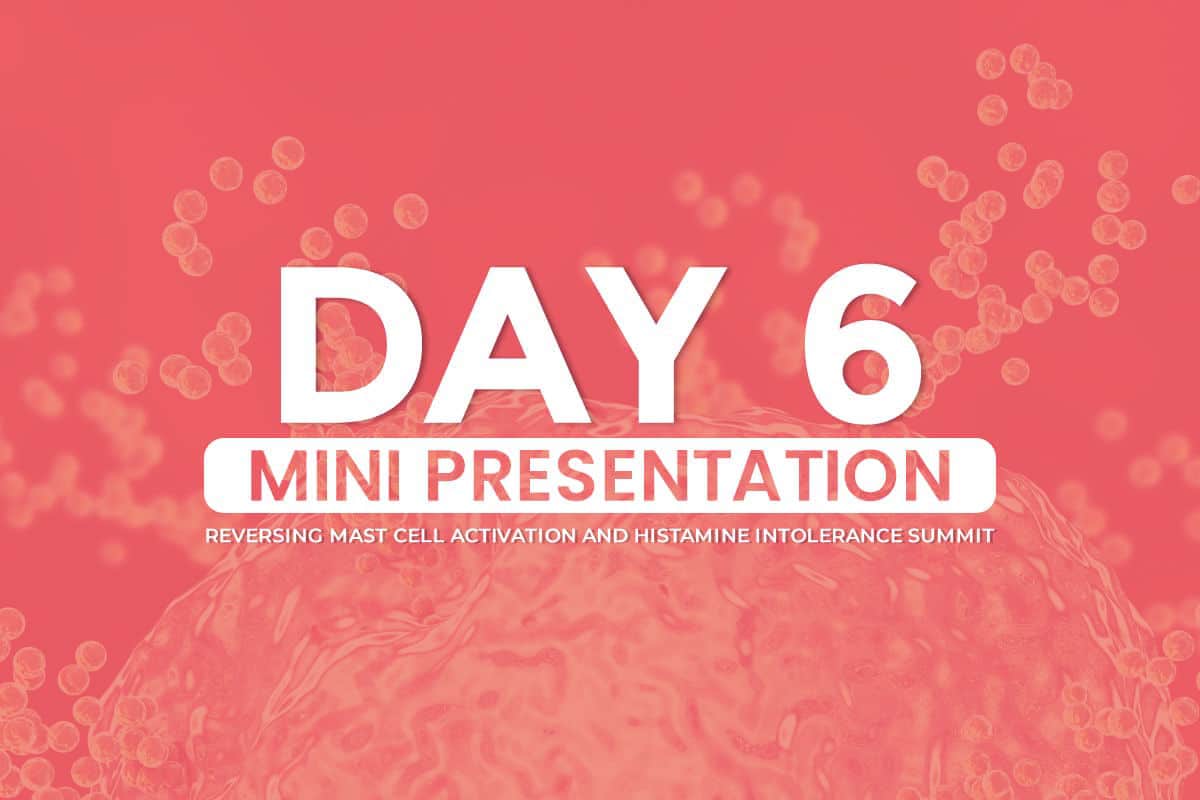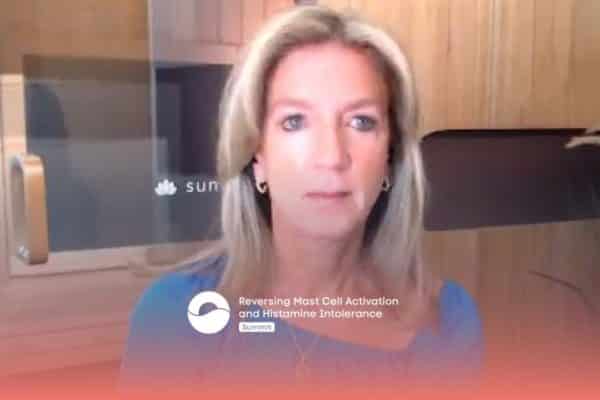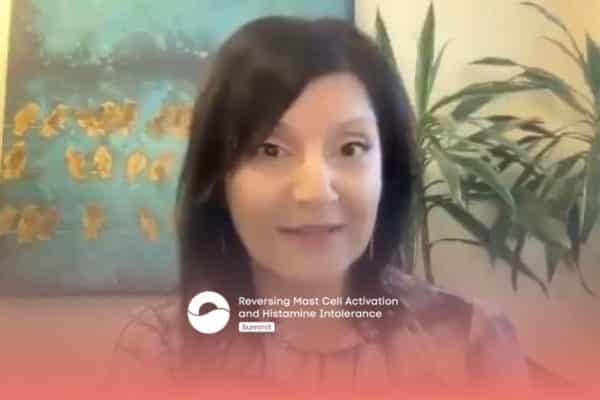Join the discussion below

Beth O’Hara is a Functional Naturopath, specializing in complex, chronic cases of Mast Cell Activation Syndrome, Histamine Intolerance, and Mold Toxicity. She is the founder and owner of Mast Cell 360, a Functional Naturopathy Practice designed to look at all factors surrounding health conditions – genetic, epigenetic, biochemical, physiological, environmental,... Read More
- How common is trauma in MCAS?
- How stored trauma can block healing
- Returning to a felt sense of safety to heal trauma
Related Topics
Adaptation, Attachment Therapy, Biological Trauma, Childhood Trauma, Emotional Health, Emotional Outbursts, Foster Care, Healing, Healing Journey, Healing Self, Mast Cell Activation, Mcas, Reaction, Rewiring Trauma, Sensitive People, Stress, Stuck Points, Talk Therapy, Therapy, Traditional Ways, Trauma, Trauma Background, Trauma Field, Trauma Self, Trauma Types, Traumatized Culture, Types Of Trauma, War VeteranBeth O’Hara, FN
Welcome back to the reversing Mast cell Activation and Histamine Intolerance Summit. I’m your host, Beth O’Hara of Mast Cell 360. And I’m so happy today to have with us, somebody’s whose work I really love and respect, and has been game changing in our community, and that’s Dr. Aimie Apigian, and she’s also a good friend of mine. Let me tell you a little bit about her. So, she is double board certified medical physician in both preventative and addiction medicine. She has two master’s degrees, one in biochemistry, one in public health. So, you’re talking about a lady who has quite a bit of education in these areas. And she’s the leading medical expert on addressing stored trauma in the body through a signature modeled methodology she developed called the Biology of Trauma. And this is a new lens that really reverse engineers trauma’s effect on your nervous system, and on your body at that cellular level. And it’s a much more effective model than the traditional models for addressing trauma. So, I’m really excited about this interview. I think you’re gonna find some new elements to your healing that will greatly accelerate your journey. And we’re gonna dive into why that is, and how you can go on with that. So, welcome, it’s so wonderful to have you with us.
Aimie Apigian, MD
Beth, thank you. It’s always good to chat with you. And I think this is gonna be a really important and helpful conversation for many people.
Beth O’Hara, FN
Definitely. And it’s been huge in my own healing journey. I know I’ve shared with you and some of our community that I’ve had my own trauma background. And I found both in myself, and I see again and again in sensitive people, this is often one of our stuck points. But then, those traditional ways of addressing it, like talk therapy, actually keeping people stuck. And I think, let’s first start about what got you interested in trauma? Why did you shift into this field?
Aimie Apigian, MD
I used to be in a stuck one, Beth. Speaking of being stuck. Like that used to be me, right? And so, as you say that, it takes me all back right there. It’s like, “Yeah, that’s exactly where I was.” And that’s exactly why I went on my journey to figure out, how to get unstuck. Beth, I’m still just amazed. When you read my bio and I hear all these degrees that I have, and I’m like, “Yeah, yup. There is so much that I have poured into.” I mean, I’m calculating that I spent tens of thousands of hours studying these stuff. And it was not for the intention of bringing the biology of trauma to the world like it is now. And I’m just so amazed that that’s what has happened because it literally was just for me to find answers for my son, and then myself. That was as big as my view got. And my son was really stuck. I thought that he would do well. I thought that when I brought him into my home, he was four at the time when he came. I was so excited. I was going into that just was so much potential. Did not actually go into that knowing that I would adopt him. But when the social workers-
Beth O’Hara, FN
In foster care.
Aimie Apigian, MD
He did exactly, came as a foster child, and I was in medical school at the time. I wanted to make my life be of more service, and had some open space. And so, that’s what I decided to do. When the social workers said that he would go to a group home, at age four, if I did not adopt him, then that really pulled on my heartstrings. ’cause I could see such a great kid behind all of his behavioral problems, and all of his emotional outbursts. And so, that weighed heavily on my heart. He had to make that decision though, right? ‘Cause I’m not, I can’t just decide to be someone’s mom. He had to decide that he wanted me to be his mom, certainly by that age. And just the excitement that I had going into that relationship of what it would be like with him. And so, for two years into this when he’s in my arms, and we’re doing all this attachment therapy stuff, and he’s telling me, “Mommy, tomorrow, I’m going to kill you.”
Beth O’Hara, FN
Oh, my gosh.
Aimie Apigian, MD
“But not today, tomorrow, Mommy.”
Beth O’Hara, FN
Oh, that’s terrifying both for you and for him.
Aimie Apigian, MD
Right? And then for him to actually tell me how he planned to do that.
Beth O’Hara, FN
Mm.
Aimie Apigian, MD
And for him to be laying in my arms, calm as could be, like, this was just, it was almost as if it was just any other ordinary conversation for him. And it was at that moment, Beth, that I’m like, “We are really stuck.” The pain that my heart felt, ’cause certainly, going into that, wanting so much to have a relationship with him where we would connect and he would see me as a resource for him. And what I saw happening, was that no, he was still rejecting me. He didn’t see me as a resource. He still saw me as a problem. And that problem was, I was challenging his heart, and he did not want to open up and he did not want to… He actually didn’t wanna be a kid. He would pretend to be this all-grown up, and I don’t need anybody. And that was his way of protecting himself, and kind of trying to say that no one would be able to ever hurt him again. ‘Cause he had been hurt. He had been hurt a lot. And so, we’re there and I’m stuck with him, right? And yes, we have our miracle story, and it’s not really a miracle when you look at all the work that goes into, that went into healing. But it took us six years.
And I wish that I had known now, back then, because it would’ve been very different. It would’ve been a very faster process for healing for him if I had had all of the tools that I have now. But this is how I learned. Like I didn’t have the tools back then. But one thing that happened, Beth, is that I started seeing myself, in my son. And I was like, “Oh, my goodness.” Like I protect my heart. No, it doesn’t look like that. I don’t go, and I don’t tell my mom that I’m planning to kill her, that’s on a different level. But I guard my heart, I keep people out. I see love as dangerous, and look at how that plays out in so many areas of my life, ’cause it’s actually not just relationships, it’s actually also then my schooling, my career, and even the choice of career that I’m choosing, These types of patterns become us. And we think that it’s our personality, we think this is us, and we’re not realizing that this is actually our trauma-self, and we’re operating from that place of trauma, and that it can be rewired, reorganized, and we can live from a healing self.
Beth O’Hara, FN
That was so grateful that you shared that story. And, oh, my gosh, the courage it took for both of you to work on.
Aimie Apigian, MD
I am just so proud of him. When I think back of how scary that was for him, ’cause I certainly would not give up. And more than anything, I wanted to see him just happy, just happy. I just want you happy Miguel. And to see how hard he had to work to look at what was holding him back, and to allow me in. And then, we got to the point, Beth, where he was actually able to tell me some of the most beautiful and hard things. Because when it came, the next piece of our story after six years, and he’s got his heart open, and he’s loving me, that feels safe to him, he wants it. And then, life circumstances brought us to the point where I am now having another family adopt him. And the work that he did, Beth in order to get to that point where during that process, we’re able to have open communication and him being able to tell me, “Mom, this hurts.” And he’s not acting it out. He’s actually being able to use his words and communicate that. And I’m looking at him just being like, “Wow, what an incredible… Ah, what incredible journey you’ve had that required such bravery.” Ah, I’m his biggest fan. Mm-hmm.
Beth O’Hara, FN
Yeah. And I love also that you were able to work with yourself through the process. And that’s a technique that I use with a lot of my clients who have a hard time loving themselves, is to have them imagine a beloved child, and will usually use the beloved child, someone, it might be their own child at two or three, or a nephew or a niece, or someone at that really precious age. And imagine that person coming and saying, “I’m hurting. I’m so sick. I’m struggling.” How would you love that person? And then, be able to convert that love back to yourself? That’s how we need to treat ourselves, is the same way that we would treat a precious child. But it’s so hard because of, we live in this traumatized culture. And gosh, especially the last couple years, we have this global PTSD happening. So, this is a really relevant. And I think that’s an example of what that amazing story they shared of a type of trauma, but there’s lots of types of traumas and ways that it shows up. Can you talk about the different types of trauma? And a lot of times people think about trauma either as being what we could imagine Miguel must have experienced as a young child to lead him to that state or a war veteran. And I find that very few people recognize their own trauma.
Aimie Apigian, MD
And I love that you’re going there, Beth, because I honestly don’t think that I would have seen my own trauma if it wouldn’t have been for Miguel, and him almost like throwing it in my face. I had to do my own work. Because, otherwise, I was starting to react to his trauma, and I knew that that wouldn’t be helpful. So, when I saw myself starting to react, then I am being able to start to see my own patterns in his patterns. It allowed me to see my own stuff where before that, I never even saw it. So, I would’ve been one of those who had said, “Trauma? Me? No, like that is not me.” Yeah, you know, my family, you know? Like, yeah, we had our times growing up, but I wouldn’t have seen that as trauma. And so, I love that you’re bringing this in the conversation where we can look at, even just defining what is trauma? Because many people misunderstand stress when it’s actually trauma. And so, trauma is something that is like a reaction. It’s an adaptation of the body to an experience.
It’s not necessarily to an event, it’s the experience of that event. It’s what does that event mean for you? And so, our body is responding to that experience based on its meaning. And so, this is where something really small, like somebody looking at you wrong, or being in elementary school and your group of friends goes off without you and leaves you behind for lunch. And you can look at, what would’ve been that experience for you? And then, did you have resources to go to? Or were you also feeling alone and isolated and your teacher didn’t seem to understand you? Or you go home and you can’t even share that with someone because your parents are just focused on your grades, and your productivity, and get your chores done, and get your homework done, so you don’t even have that place to process life? And then, that’s what happens. As we are not able to process life as we go through it, then that actually becomes a trauma for us, and shows up in our nervous system patterns.
And we continue to respond and react to future life events based on those patterns that have been kinda ingrained through these prior experiences. So, it’s really not events. We can look at events and be like, “Wow, that may have been traumatic.” But we really don’t know even, even a severe event. ‘Cause I’m thinking of the military, and there’s many people who come back from the military, not having PTSD, but some do. And what’s the difference? Some people are in the same family. Some people are in similar neighborhood, and some people are walking away with severe forms of emotional challenges and trauma patterns and some are not. And what’s the difference? And that’s where we really need to look at. It’s really not about the event, it’s about how our body is being able to move through those events. How is it able to respond to those events at that time, not later on in life, but at that time, can it be processing and integrating this stuff as we move along? I look at a lot of adults, Beth, and as we move into adulthood, one of the easy ways to see if we have trauma patterns is actually looking at how a person handles loss and grief.
If you don’t have any trauma, you are able to feel all of your feelings and move through all the stages of grief, and it be the healthy grieving process. But it’s when you have trauma patterns that it brings up stuff, it brings up old losses that you haven’t, that you didn’t process at that time, and so, now it’s almost compounded. You’re not just dealing with your present day loss, you’re also trying to process all your other losses that you’ve had in life. That becomes too much, it’s way too much. And so, our system then goes into, what is the trauma response? And it gets overwhelmed, and it almost like it compartmentalizes it, and it says, “I can’t deal with that now, it needs to go away. It needs to go into this box. I’m gonna put it into this box, and maybe at some point in the future, I’ll have enough resources to come back out and pull that box out.” But that’s just one more trauma then, that gets stored in our body because we haven’t been able to process it in the moment as we are going through an experience.
Beth O’Hara, FN
And I think too, especially for this community where we’re talking about mast activation syndrome. We’re talking about, in some levels systemic intolerance. But we’re talking about people who have some pretty significant chronic health issues. They’ve had mold toxicity, they’ve had Lyme. They have, usually by the time I meet with somebody, they’ve usually seen at least 5 to 10 practitioners. Didn’t know how to help them, the systems have failed them many times. And I hear every single week in my practice, “You don’t look sick.” People are being told this, “You’re you’re overreacting. I think you’re just a hypochondriac. Your blood work looks just fine.” In addition to have people had early childhood stressors or they maybe had a surgery, or they, for example, my husband had colonoscopy one time where the anesthesia didn’t work on him. So, he was lucid for the whole thing, but he couldn’t move. So, sometimes people have these kinds of experiences, and there’s so many different ways that it can show up.
I had a car accident several years ago and I was T-bone from the left and I saw the car coming. There were parked cars on both sides, I had nowhere to go, so I was trapped. I was accelerating, trying to get outta the way, and I was breaking hard, trying to get the way. And it didn’t matter what it did, I was gonna get hit. And it was pretty badly injured and I’m still recovering years later. So, I still find that it’s better, but when I started driving again, every time anybody, even if they were going slow coming to light, I was just gripping, and tense, and jumping. Even as a passenger, my husband would be like, “What’s going on?” I’d be jumping out of my seat because my nervous system was expecting everybody to hit me. So, we have all these ways that it can show up. And I just wanna put that on the table for people to be thinking about what might be there for them? But all it can show up in weird ways too. Like I took me a long time to realize that my terror that would happen when I would be pinned under the covers. So, my husband would come, I’d be under covers ready for bed, and he was hot, so he wouldn’t get outta the covers.
So, he would lie down, and I would just lose it, Aimie. I would be like, “Get off the covers. Get off the covers.” But I couldn’t move. I couldn’t get out of bed. And I had to actually make a plan for before he got into bed, I was gonna get up. and I had to work on that because I would get trapped and stuck in that. So, I know these are some of these descriptions of the different states of the nervous system you talk about. Just before we go there as a juxtaposition, can you talk about just what it’s like when somebody has either healed their trauma or they didn’t have any trauma? And I rarely mean anybody doesn’t have any trauma. But I know they’re out there. What is that like? ‘Cause I think it’s helpful to think about what’s the contrary to see where we are at the moment and how much trauma might be affecting us?
Aimie Apigian, MD
There are very, very few people that I have met, who I would say their nervous system does not have stored trauma. Because it certainly is the majority. And for the majority of us, it actually started in early childhood with things that are just normal social practices that we would never even know are traumatizing to a baby. But it starts this dysregulation in the nervous system, which then, leads to dysregulation in the immune system, and certainly, can contribute to all kinds of things. There’s actually different adaptive immune patterns that I’ve seen, one of them being Long Haul Syndromes. One of them being this very chemically sensitive and overreactive immune system. So, these are very predictable patterns that come out of very early dysregulation. So, when I’m looking at, what does that healing journey look like? Like I’m actually talking about all of the span of one’s lifetime, not just looking back at one event.
But there is certainly a time when we need to process one major event or one major experience that we are still overreacting to. And that would be how people show that they’re healing on that journey, is that, for you being able to actually be under the covers, and it not drive you to insanity and craziness in the moment where you can’t even move, right? But the healing journey for many people stops when they would just be like, “Well, I’m just gonna get out of the covers so that it just won’t ever happen to me.” Like I won’t ever feel that way anymore rather than being able to say, “Well, actually, let me work all the way through this so that I can actually be under the covers, have that felt sensation, and still be able to respond.” And so, when I think of the difference between still living from our trauma self versus living from our healing self, it’s the difference between reacting and responding. When I’m reacting, it’s all emotional. And when I’m responding, there’s a balance. It’s not that it’s not emotional, it’s that there’s a balance between my mind and my body. I’m able to think about it, I’m able to analyze it. I’m also able to incorporate my feelings about it. It’s a well rounded, balanced approach to responding to a situation. When we look at the reactions that people have, we actually see two different types of reactions.
One is the reaction of anger and lashing out, and like that overreacting. And yet, there is this whole other pattern of reacting that people may not think of as being trauma, because it’s not the big overreactions, it’s actually underreacting. And that is what we call the freeze response. And so, this underreacting is where I won’t say anything. I feel the impulse to say something, but I’m not, I’m holding it in. Or, “Ooh, I wanna do something that doesn’t feel right. I wanna do something, but I’m actually not going to do it because of how it might look, or how they might perceive me, or I might do it wrong.” There are many different influences to underreacting, but both of those, overreacting and underreacting are both coming from a trauma place. So, when we see ourselves being able, it’s almost like Miguel, right? Like I go back to Miguel and I’m like, ah, like Miguel was able to move through that experience. That is awful, right? Like it’s still the hardest thing that I have ever been through, that my heart has ever been through. And for him, and us to be able to navigate and move through that experience, communicating and staying open in our communication throughout the whole thing, that is living above our trauma self, right? Like that’s coming from our healing self. It’s not that we don’t hurt, it’s that we don’t shut down because we don’t wanna feel the hurt. Or we don’t lash out at other people in order to not feel the hurt that’s inside of us. So, we look at being able to respond to life, being engaged in life, and not shutting down, not underreacting, nor overreacting when life brings its challenges to us.
Beth O’Hara, FN
So, there’s what I’m hearing, is there’s a resiliency in being able to respond to what’s occurring in our lives? And we can respond with a healthy, emotional response. We can feel our feelings, we can express our feelings, we can express our needs, wants, and wishes? And we don’t feel like we have to walk on eggshells, or we have some people get overly demanding because that’s the only way they were able to get their needs met? We can show up and there’s a type of equanimity where we can roll with what’s happening. I lost your sound there for just a second.
Aimie Apigian, MD
My apologies. I was telling my dog to be quiet.
Beth O’Hara, FN
Oh, gotcha.
Aimie Apigian, MD
I didn’t want her barking to show up in our recording.
Beth O’Hara, FN
Well, we can roll with her too. Well, so we we’re talking about these three states of the nervous system. Let’s go deeper into the effect trauma has on the immune system. ‘Cause there’s a much higher percentage of people in the chronically ill population who have trauma that affects the nervous system development. It affects that limbic vagal mast cell axis, is how I think about it, with the mast cells being that interface between the nervous system, and talk a lot about the feedback loop, the communication loops with the nervous system and the mast cells. So, the mast cells can respond within seconds even to thoughts. And I’ve done experiments that I’ve shown our community where, ’cause my hands swell, is one of my first symptoms, so it’s really obvious. And so, I can spiral on a stressful thought, or go to a traumatic memory, and within a few seconds, my hands will swell. But then, I can shift my state. And usually in less than a minute, the swelling will go back down. And so, if that’s happening in my hands, is helping throughout my system, either towards that activated state and inflammatory state, or anti-inflammatory. So, I really monitor my internal state, and monitor my experiences and monitor how I’m responding. And if I’m getting over stimulated, I gotta pull myself back, and work on that. I work on that every day because of how powerful it is. So, can you tell us more about that biology?
Aimie Apigian, MD
Yes, and the nervous system and the immune system are like two peas in a pod, right? Like they run together. You cannot affect one without the other. And it goes both ways. Like you’ve just shown the nervous system immediately, in seconds, is causing an effect on the immune system. And it’s the other way around too. The immune system is also talking with the nervous system. And so, many times people are coming in and they’ve had these chronic influences on their immune system because of the nervous system dysregulation, and now they’re trying to do a therapy process. Now, they’re trying to do some personal development work and, all right, I’m ready to pull that box out that I’ve had hidden for decades. Time to time to look at that. And what they’re finding, is that their immune system is keeping their nervous system stuck because of the inflammation, because of the high histamine, because of all of this stuff that’s impacting the nervous system. Histamine it’s like an irritant for the nervous system, it can be.
And so, you’re not going to be able to get the nervous system to that place of feeling safe and secure, and let’s have some positive neuroplasticity, and rewire some of these negative or trauma patterns that have been embedded into the nervous system. So, both are essential. And I love how you talk about that in the work that you do, Beth, where it’s like, we’re not just gonna look at the nervous system. We’re not just gonna do changing our thoughts, and we’re not just gonna do the biology. Like we really have to look at them together because that’s how it actually works in the body. And when we look at the immune system in particular, we can see clear associations between the two of them. And for me, the clearest has been through the work with the adverse childhood experiences, and being able to see that they’ve shown that stressful childhood experiences, ’caused something. And there’s that big question mark, of what did that do? Because decades later, two decades later, three decades later, they’re having immune related diseases.
Beth O’Hara, FN
And can you share first people who that may be new to them, what the adverse childhood experiences are? And what type of experiences those might be?
Aimie Apigian, MD
Yeah, that’s really important to know, because if we’re gonna say that there’s an association between those and adult inflammation, we need to know exactly what experiences those were? So, this was a study that was not expected. This came out of a surprise from the work that Dr Follette was doing at Kaiser in San Diego with his weight loss clinic. So, he was in charge of the preventive medicine department. And one of the things that we all know in medicine, at least, is that obesity is one of the leading preventable causes of mortality and morbidity. And so, from a medicine standpoint, one of the best things that we can do as a society, is to help people lose weight. So, that’s what they were doing. They were doing that for the express intention of reducing the morbidity and mortality in the United States. And what they found, was that they were able to give these patients, mostly female.
They were able to give them a liquid form of calories that mimicked fasting. And so, they were able to lose quite a lot of weight over a short period of time, and apparently safely. And so, they were putting these people on this diet and they were losing hundreds of pounds, Beth. One lady that the Dr. Follette shared with me, lost 300 pounds, over the course of a year. She should be thrilled. And at the top of her game and just living her best life. She’s just become a healthy weight person in the course of one year. And yet, what they found, was that their most successful patients, were the ones dropping out of the program and gaining all their weight back. And it irritated them because it was messing up with their numbers, right? They’re supposed to be showing that this works. Why are you dropping outta my program and gaining all your weight back? This is not okay. So, they went and they started interviewing and talking with these patients. And what they found, shocked them. One patient in particular, really expressed it well, when she told Dr. Follette, “You think that the weight is the problem.
The weight, being obese is the solution to my problem.” And so, we find that there are these life experiences that ’cause things. And whether that ’causes things like anxiety, like depression, or just generally feeling unsafe, or for some of them, they had had sexual abuse. And being overweight helped protect them. It helped them feel safe. And so, it was a really, really helpful, I think, initial study to show the importance of feeling safe and the different coping mechanisms that each one of us uses. For them, it was food. For me, it’s been other things, but all of the things that we will do unconsciously, even, in order to feel safe. And so, they started interviewing more and found out that there were different events and they put all of these events in a test, so a questionnaire that you can fill out that questionnaire and get your score for your adverse childhood experiences. And they broke those categories up into emotional, physical, and then household challenges. And the benefit of this, is that people can actually start to understand, that those events in their childhood, weren’t just in their childhood. Like they have followed them, it has stayed with them. It got in their body, and so, it is part of their body now, it’s not something that they can say, “Well, that was in my childhood, so that shouldn’t matter.” But the other thing that it helped bring in, was this idea around safety. And so, then we can look at the work that Dr. Steven Porges has done with the polyvagal theory, and has shown that all healing, whether that’s physical healing, whether that’s emotional healing, all healing requires safety at its base.
We cannot heal without a felt sense of safety. And, Beth, this is where many people have… I mean, we’ve been taught this, so it’s no fault of their own. But we’ve gone down this trail of mindset, and it’s just a matter of what you tell yourself. Change your thoughts, change your health. Change your thoughts, change your, and then just fill in the blank. And it’s true to a certain degree. And that certain degree, is that you cannot tell yourself that you feel safe when you actually don’t feel safe. Your body will not lie. We can try to lie to our body, but it’s our body that at the end of the day, is going to be carrying out it’s feeling of safety, or it’s feeling of unsafety. It’s not our mind that decides that, it’s our body that decides that. And that’s where it really is the nervous system, ’cause it’s the nervous system that decides, the peripheral nervous system, it decides, do I feel safe in this moment? Do I feel safe in the world? Do I feel safe with my neighbors? Like we can ask some really existential types of questions around safety, and we can see that most people are walking around right now, not feeling safe. And when we really ask them, Beth, when we really ask them, they will tell you that for most of their life, they have never felt truly safe.
There’s always been this element of, I don’t know if I’m okay, or it may be okay right now, but I’m waiting for the next bad thing to happen. And that’s how their nervous system has been wired. And so, it’s been an opportunity. I think even just the last two years has been actually a big opportunity, a big invitation for us to actually look at this and see, wait a second, if my best health is from my ability to feel safe in my body, that’s what I need to focus on. It’s actually not all of that stuff. It’s actually coming into myself, do I feel safe? “Ooh, no I don’t. How long has this been here? How come I didn’t know this before? And how do I create a felt sense of safety? And it not just be something that I’m telling myself, but not actually feeling in my body? When we feel that, we can then actually feel all of the bracing patterns and the tension patterns that we have, because we haven’t felt safe. That just weren’t even in our awareness because we didn’t even know that we weren’t feeling safe. And so, we weren’t even aware of all the things that we do to brace ourselves, to push ourselves in order to survive. So, it’s a big invitation for that.
Beth O’Hara, FN
And that’s exactly what our mast cells are doing as well. All those receptors, is this a safe state? Is this a safe? Because they’re sensing every molecule of air-
Aimie Apigian, MD
Every molecule.
Beth O’Hara, FN
Everything in and going into our mouths, everything we drink, everything that we breathe, everything that we touch. But they respond to every thought, every stress. They respond to every movement, they respond to injuries. And when I talk about this. Now, when I ask my clients if they feel safe? They usually tell me, yes. And I know, because I know how to read people’s nervous systems, if you don’t. So, then what I say is, “Well, feeling safe is that sensation like when you’re in your favorite place in nature and you’re on vacation, and everything’s perfect, and there are no stressors and there’s nothing to worry about. And the temperature’s just right, there’s no bugs. The wind is just a light breeze, and you’re just at ease. That’s safe in the body. And then, they go, “Oh.” And I say, “Well, do you feel like that on a daily basis?” They’re like, “Oh, no. Maybe felt that a couple times.” That’s what we need to recreate every day.
Aimie Apigian, MD
Exactly. Yes.
Beth O’Hara, FN
And so, dialing down mast cell activation, we talk a lot in this summit about Cell Danger Response. And so, this all ties in beautifully with that. And so, to settle mast cell activation, we have to feel safe. And I find a lot of times, people, they may have mold exposure they’re not aware of, and we’re inhaling those molecules, well, that goes right to the limbic system. So, it’s like, whoa, there’s that, I’m not safe because that’s not safe. I find a lot of people are toxic relationships. Whether it’s a social group, it’s a partner, it’s a parent. I’ve had a lot of people who worked in workplaces with somebody who was really toxic. So, there was an abusive component on a daily basis, and they were stuck because of that. So, there’s this component of, sometimes people truly aren’t safe in the moment, and that has to be addressed. Or this piece of, there was this lack of safety, and we’ve not, in earlier parts of our life, and we’ve not unwound that, and come back to, I’m safe today. And that was one of the real challenges that I had because I couldn’t ever feel safe. And even, with people who were close me, even with my husband, who’s the safest person in my life, but my body wouldn’t let go, until I did this work that we’re talking about. And so, this is really key in particular, a lot of people have trouble, they’re not tolerating any supplements, any medications.
We’ve looked at all of the external triggers, they’re still stuck. This is the next step for them. And I also find, so there’s this perception that trauma work is, we’re gonna go to talk about it and we’re gonna pull. Like you were saying, “Pull that box out,” which has its place. But if we are in these places of chronic illness, the limbic system doesn’t know the difference, in the rest of the nervous system between, let’s talk about it and unpack it, and have a framework for understanding it or developing tools. And I’m telling this story in to the nervous system, it’s just hap… I’m being reabused, or I’m in that car accident again. Or I’m getting kicked by that horse again. It’s just like it’s happening again every day. So, the more we tell a story, it’s in the nervous system it’s more that’s happening, and then, people get in these bigger flares. So, I tell ’em, don’t do that work while you’re getting out of the chronic illness. You can do that later if that’s gonna be helpful, but not right now. So, how do people get started with this work that you do? And that’s what I love, is you’re looking at it in the biology framework. You’re looking at it in terms of the neurology, the immunology, not, this is your thoughts, or this is your, it’s in your head. And you could just change your feelings, that’s not how that works.
Aimie Apigian, MD
No, it’s not how it works. And I’m remembering so many times when I had flare ups of my physical health symptoms as a result of trying to do too much of therapy. And so, that’s why I designed my sequence of how do I guide people through the process in a safe, gentle way? Because we do need to look at the biology. We do need to look at the nervous system. But we can also do it too much, too fast, and actually flare up symptoms. And for me, that’s a sign that, “Yeah, that’s too much for the body.” And we need to follow the pace of the body. And we can also support the body to be able to go at a bigger, at a faster pace. So, where I start people, is looking at the level of dysregulation of their nervous system in the current moment. And then, I’m just trying to take that down a notch best. I’m not trying to take it down to zero.
I’m not trying to take it down to zero stress. But I do know, that wherever we’re starting with their biology, we need to take that dysregulation, down just a notch. Because when we do that, it opens up more energy for the system to start to heal itself in all of these other areas in the immune system, in the digestive system, in the mitochondria, in the microglia with the brain. That just opens up energy when I can take the current level of dysregulation in the nervous system and just bring it down a notch. So, that’s where I start Everybody, which is why I start everybody with my “21-Day Journey,” because I’m teaching you, I’m giving you tools to shift that down just a notch.
Beth O’Hara, FN
And that’s so key what you just said. Because being in that stuck, whether we’re in the fight or flight, or in the free state, does take a huge amount of resources, huge amount of energy. Even being frozen, where’s a lot of energy.
Aimie Apigian, MD
Yes, Mm-hmm. And actually, it takes a lot of energy for us to tell ourselves that we feel safe, and our body giving us a different message. Like when our body is giving us a different message and we’re trying to like put the lid on that, that lid takes a lot of energy. So, being able to just take that intensity down, Beth, and shift it towards just a little more regulation, then allows us to do more work on the biology side. And as we do work on the biology side and we identify, Hey, like what’s going on in your nervous system? What’s going on in your immune system? What’s going on in your toxins, in the mold, with the histamine? What’s going on there? Then as we address that we have, guess what? A little more capacity over here to work on the emotional stuff. Awesome. So, we’re gonna do a little more over here. And when we do that, it opens up a little more energy for over here. And so, it’s this being able to do them together, and they act synergistically on each other. And it’s almost like the body, then is, it’s just carried on this healing journey and it’s not, “Well, go over there for that piece. Oh, okay, now you’re done with that piece, go over there for that piece.” ‘Cause it’s not compartmentalize that, but it all happens together, and so, we need to address it all together. And so, being able to work with the nervous system and those three states, and coming out of the stress, and the free state while we’re working on the biology, that’s when the magic happens. That’s when we’re really able to make significant progress faster than if we were just trying to do the biology piece and then you go over and do the therapy piece.
Beth O’Hara, FN
Yeah, and I find that people can really unwind these stuck places, these places where they’re not tolerating anything and they’re reacting to everything. And we start to add this work in. And I’ve taken some of your courses, which I love. And I can share that now. So, where I started with my under the covers issue, was I use some of the techniques, and I would start with my dog. ‘Cause my dog is not a human, so one that helps. And two, my dog, I have a little pet mix, and she’s just the biggest snuggler. She’s a 55 pound lap dog. So, she loves to get up on me, and I would be under the covers and let her up. And then, I would do that work and remind myself I’m safe, and I’d do little short bits, little short bits. So, I kept working on it to where now, I can be snuggling my husband, he’s on one side, she can get up on the covers on the other side, and I’m okay, and I have that freedom now. And I have that freedom in nervous system where I’m used to, I was in a full blown, frozen panic attack and couldn’t do anything. I know I’m springing this on you, but is there just a short technique you could share with people as a teaser on how they could just get started into this kind of work?
Aimie Apigian, MD
Oh my goodness, Beth, there are so many. And let me see where I want to start. What one would be a good one to share? Probably, the one that’s coming up for me right now, is just the one that I will share. And it’s actually not one that I share in the “21-Day Journey.” This is an additional one and it’s just noticing your breath. And I don’t want you to change it, but I just want you to notice how deep it goes. And I’m noticing that my breath feels like it’s just… Let me notice again. Many times people will notice that their breath is actually more shallow than they thought, like, “I only feel my breath going down to the bottom of my throat or maybe mid chest.” And so, when you notice, wherever you notice, don’t try to change it, just notice it. And then, when you do notice it, just see if you can increase it just a little bit. I actually don’t want you to try to increase it a lot, ’cause that might be too much too fast. When we’re doing this work, Beth, we really just wanna go small. Small steps because that allows the body to integrate it as we go through. And so, if you wanna just intentionally just try to take your breath a little deeper. And I noticed that as I did that, like my shoulders came back. I sit up straighter, I’m coming out of out of a posture that would be more of like the freeze response, and you’re kind of folded over. My shoulders come back. And so, just that noticing and becoming aware of, Hey, how shallow or deep is my default breath? And then, can I just take it a little bit deeper right now? Just that will make such a big difference for the nervous system.
Beth O’Hara, FN
That’s a lovely technique. Thank you for sharing that.
Aimie Apigian, MD
Yeah. Thank you.
Beth O’Hara, FN
This has been an amazing interview. We really appreciate that your time, your journey sharing. And I just wanna express my gratitude for the work that you do. It’s really game changing, and makes a huge difference for people suffering with these chronic illnesses.
Aimie Apigian, MD
Thank you, Beth. And right back at you. You know that I love the work that you’re doing, and so important, ’cause so many people with trauma patterns, the mast cells, and the histamine is a big part of their story. And so, really thankful that you’re doing this work.
Downloads

